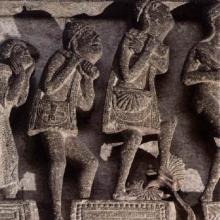I wanted to make a pilgrim's satchel, the type of bag that one would wear in the mid-12th century while making a pilgrimage. There are several images of satchels and shoulder bags, but specifically the one's that I tried to emulate are David's bag from "David and Goliath in the 'Worms Bible' (British Library MS Harley 2803 Folio 126v)" which is around 1148, and a carving of "Pilgrims from the Cathedral of Saint-Lazare, Autun (ca. 1120-1130)"
Tools:
Sharp Knife
Mallet
Awl
Stitching Forks (I don't know a better name for them. An awl would be a more historically accurate way to do stiching holes, but for speed I used the fork that puts down four holes at once)
Steel Needles (I don't have any historical needles)
Materials:
Waxed Linen Thread
Artificial Sinew (I don't have access to real sinew. Artificial sinew provides a cost effective, strong substitute)
Some 6-8oz vegtable tanned leather. The cut was from a piece of double shoulder.
Water
I made my bag from part of a double-shoulder of veg tan leather. I figured that since this one is a prototype, I would use the piece of leather that turns into the cow's leg for the opening flap, that's why it's a little bit of a rough piece. It was a pretty economical use of the hide though.
The steps were to:
1. Figure out a size, and make a pattern. I wanted a pretty large bag, so I tried to copy the dimensions from the cathedral carving. My bag is made from four pieces, a front, a back (that also folds over into a flap) the side/bottom, and a shoulder strap.
2. Cut the pieces. I used a sharp knife.
3. Punch for stitching. For stitching, I used a modern stiching fork to get regular holes. A more historical alternative would have been to use an awl and measure out each hole individually, but for time I used the punch that does five holes at a time.
4. Stitching. I stitched the entire bag with the flesh side out, so that my stitches would be on the inside of the finished piece. I had a good idea for the lip of the bag, and folded it over on itself in order to give the bag better structure when it was opened. I used a waxed linen thread for the exposed stitch on the lip, and an artificial sinew to stitch the inside of the bag.
5. After the bag was completed, I filled it full of water in order to soften the leather to allow me to turn the bag inside out as well as shape it to the dimensions that I wanted. I was pleased that my stitches were tight enough to hold water!
6. I finished the bag by oiling it. I paid special attention to the hinge point of the flap because it will get the most wear.
8. After the bag was done, I added some small ears to prevent water from running down the straps into the bag. In the future, I think that if I attached the shoulder strap to the back of the bag it would preclude this problem, and make for a more streamlined article.
The next bag I complete, I want to make a couple changes. Like I stated earlier, I think that moving the attachment point of the shoulder strap to the back would be pragmatic, and streamline things. I would also like to use a better cut of leather for the front flap, and to tool a design like a cross or shell. It would be a lot more work, but using an awl for all the stitching holes would also be cool.
David and Goliath in the 'Worms Bible' (British Library MS Harley 2803 Folio 126v)" which is around 1148, and a carving of "Pilgrims from the Cathedral of Saint-Lazare, Autun (ca. 1120-1130)"

